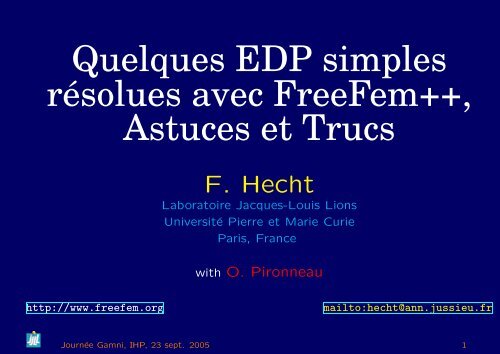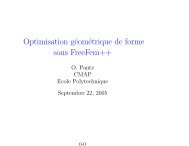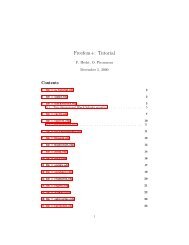Quelques EDP simples r´esolues avec FreeFem++, Astuces et Trucs
Quelques EDP simples r´esolues avec FreeFem++, Astuces et Trucs
Quelques EDP simples r´esolues avec FreeFem++, Astuces et Trucs
You also want an ePaper? Increase the reach of your titles
YUMPU automatically turns print PDFs into web optimized ePapers that Google loves.
<strong>Quelques</strong> <strong>EDP</strong> <strong>simples</strong><br />
résolues <strong>avec</strong> <strong>FreeFem++</strong>,<br />
<strong>Astuces</strong> <strong>et</strong> <strong>Trucs</strong><br />
F. Hecht<br />
Laboratoire Jacques-Louis Lions<br />
Université Pierre <strong>et</strong> Marie Curie<br />
Paris, France<br />
with O. Pironneau<br />
http://www.freefem.org mailto:hecht@ann.jussieu.fr<br />
Journée Gamni, IHP, 23 sept. 2005 1
PLAN<br />
– Historique<br />
– Introduction Freefem++<br />
– nouveauté<br />
– Equation de Poisson dépendante du temps<br />
– Ecriture variationnelle<br />
– Ecriture matricielle (Optimiser)<br />
– frontière Libre<br />
– Inequation variationnelle<br />
– Méthode de Joint<br />
– Conclusion / Future<br />
http://www.freefem.org/<br />
Journée Gamni, IHP, 23 sept. 2005 2
HISTORIQUE<br />
Idée suivre le cours de calcul scientifique, Olivier, Frédéric, M2, UPMC,<br />
second semestre<br />
– Macgfem ( Olivier , ....)<br />
– freefem (Oliver, Bernardi Dominique, Prud’homme, Frédéric)<br />
– freefem+ (Olivier, Bernardi Dominique, Frédéric)<br />
– freefem++ (Frédéric , Olivier, Antoine Le Hyaric)<br />
– freefem3d (Stephane Del Pino, Olivier)<br />
Journée Gamni, IHP, 23 sept. 2005 3
c’est mes debuts en C++.<br />
Comment ça marche, / Dehli, (1992 ?)<br />
typedef double R ;<br />
class Cvirt { public: virtual R operator()(R ) const =0 ;} ;<br />
class Cfonc : public Cvirt { public:<br />
R (*f)(R) ; // la fonction C<br />
R operator()(R x) const { r<strong>et</strong>urn (*f)(x) ;}<br />
Cfonc( R (*ff)(R)) : f(ff) {} } ;<br />
class Coper : public Cvirt { public:<br />
const Cvirt *g, *d ; // les deux fonctions<br />
R (*op)(R,R) ; // l’opération<br />
R operator()(R x) const { r<strong>et</strong>urn (*op)((*g)(x),(*d)(x)) ;}<br />
Coper( R (*opp)(R,R), const Cvirt *gg, const Cvirt *dd)<br />
: op(opp),g(gg),d(dd) {}<br />
~Coper(){del<strong>et</strong>e g,del<strong>et</strong>e d ;} } ;<br />
static R Add(R a,R b) {r<strong>et</strong>urn a+b ;} static R Sub(R a,R b) {r<strong>et</strong>urn a-b ;}<br />
static R Mul(R a,R b) {r<strong>et</strong>urn a*b ;} static R Div(R a,R b) {r<strong>et</strong>urn a/b ;}<br />
static R Pow(R a,R b) {r<strong>et</strong>urn pow(a,b) ;}<br />
Journée Gamni, IHP, 23 sept. 2005 4
The main characteristics of <strong>FreeFem++</strong> (2D) I/III<br />
– Problem description (real or complex) by their variational formulations, with<br />
access to the internal vectors and matrices if needed.<br />
– Multi-variables, multi-equations, bi-dimensional (or 3D axisymm<strong>et</strong>ric) , static<br />
or time dependent, linear or nonlinear coupled systems ; however the user<br />
is required to describe the iterative procedures which reduce the problem to<br />
a s<strong>et</strong> of linear problems.<br />
– Easy geom<strong>et</strong>ric input by analytic description of boundaries by pieces ; however<br />
this module is not a CAD system ; for instance when two boundaries<br />
intersect, the user must specify the intersection points.<br />
– Automatic mesh generator, based on the Delaunay-Voronoi algorithm. Inner<br />
points density is proportional to the density of points on the boundary.<br />
Journée Gamni, IHP, 23 sept. 2005 5
The main characteristics of <strong>FreeFem++</strong> (2D) II/III<br />
– M<strong>et</strong>ric-based anisotropic mesh adaptation. The m<strong>et</strong>ric can be computed<br />
automatically from the Hessian of any <strong>FreeFem++</strong> function .<br />
– High level user friendly typed input language with an algebra of analytic and<br />
finite element functions.<br />
– Multiple finite element meshes within one application with automatic interpolation<br />
of data on different meshes and possible storage of the interpolation<br />
matrices.<br />
– A large vari<strong>et</strong>y of triangular finite elements : linear and quadratic Lagrangian<br />
elements, discontinuous P1 and Raviart-Thomas elements, elements of a<br />
non-scalar type, mini-element, ...(no quadrangles).<br />
– Tools to define discontinuous Galerkin formulations via the keywords : “jump”,<br />
“mean”, “intalledges”).<br />
Journée Gamni, IHP, 23 sept. 2005 6
The main characteristics of <strong>FreeFem++</strong> (2D) III/III<br />
– A large vari<strong>et</strong>y of linear direct and iterative solvers (LU, Cholesky, Crout,<br />
CG, GMRES, UMFPACK) and eigenvalue and eigenvector solvers.<br />
– Near optimal execution speed (compared with compiled C++ implementations<br />
programmed directly).<br />
– Online graphics, generation of ,.txt,.eps,.gnu, mesh files for further manipulations<br />
of input and output data.<br />
– Many examples and tutorials : elliptic, parabolic and hyperbolic problems,<br />
Navier-Stokes flows, elasticity, Fluid structure interactions, Schwarz’s domain<br />
decomposition m<strong>et</strong>hod, eigenvalue problem, residual error indicator,<br />
...<br />
– An experimental parallel version using mpi<br />
Journée Gamni, IHP, 23 sept. 2005 7
Nouveauté<br />
– Nouveau manuel freefem++doc.pdf merci Olivier<br />
– Table de couleur utilisateur<br />
– operateur de C++ a ? b : c r<strong>et</strong>ourne b si a sinon b<br />
– matrice d’interpolation<br />
– algèbre de matrice<br />
– Inéquation variationnelle<br />
– Galerkin discontinue<br />
– couleur dans nedit<br />
Journée Gamni, IHP, 23 sept. 2005 8
trouver u solution de<br />
Equation de la chaleur<br />
∂tu − ∆u = f, dans Ω×]0, T [, u(., 0) = u0, u |Γ = g<br />
où u0, f, g, T sont des données.<br />
On l’approche <strong>avec</strong> un schéma d’Euler implicite :<br />
u 0 = u0<br />
pour n = 0, N <strong>avec</strong> δt = T/N faire<br />
u n+1 − u n − δt∆u n+1 = δtf, dans Ω, u n+1<br />
|Γ<br />
La formulation variationnelle : trouver un+1 ∈ H1 0<br />
que :<br />
∀v ∈ H 1 0 (Ω),<br />
�<br />
Ω (un+1 v + δt∇u n+1 .∇v) =<br />
(Ω) , un+1<br />
|Γ<br />
�<br />
= g<br />
= g <strong>et</strong> <strong>et</strong> tel<br />
Ω (un+1 v + δtfv)<br />
Journée Gamni, IHP, 23 sept. 2005 9
Equation de la chaleur / standard<br />
mesh Th=square(100,100) ;<br />
fespace Vh(Th,P1) ; // P1 FE space<br />
Vh uh,vh,u1=0 ; // unkown and test function.<br />
func f=1 ; // right hand side function<br />
func g=0 ; // boundary condition function<br />
real dt =0.01 ;<br />
int i=0 ;<br />
problem Poisson(uh,vh,init=i) = // definion of the problem<br />
int2d(Th)( uh*vh+dt*(dx(uh)*dx(vh) + dy(uh)*dy(vh)) ) // bil. form<br />
- int2d(Th)( (u1+dt*f)*vh ) // linear form<br />
+ on(1,2,3,4,uh=g) ; // boundary condition form<br />
... // def table de couleur<br />
for (i=0 ;i
Equation de la chaleur/ table de couleur couleur<br />
real[int] colorhsv=[ // color hsv model<br />
4./6., 1 , 0.5, // dark blue<br />
4./6., 1 , 1, // blue<br />
5./6., 1 , 1, // magenta<br />
1 , 1. , 1, // red<br />
1 , 0.5 , 1 // light red<br />
] ;<br />
real[int] viso(20) ;<br />
for (int i=0 ;i
....<br />
Equation de la chaleur <strong>avec</strong> de matrices<br />
varf vlaplace(uh,vh) = // definition de problem<br />
int2d(Th)( uh*vh+ dt*(dx(uh)*dx(vh) + dy(uh)*dy(vh)) ) // bil. form<br />
+ int2d(Th)( dt*vh*f) + on(1,2,3,4,uh=g) ;<br />
varf vmasse(u,v) = int2d(Th)(u*v) ;<br />
matrix A = vlaplace(Vh,Vh) ;<br />
s<strong>et</strong>(A,solver=UMFPACK) ; // factorisation<br />
matrix M = vmasse(Vh,Vh) ;<br />
real [int] b(A.n) ;<br />
real[int] bcl(A.n) ;<br />
bcl = vlaplace(0,Vh) ; // les termes CL + second membre<br />
real[int] in(A.n) ; // un tableau : 1 si interne 0 si frontiere<br />
G<strong>et</strong>NoBC(A,in) ; // pour pénalisation exact de CL (tgv sur aii)<br />
Journée Gamni, IHP, 23 sept. 2005 12
Equation de la chaleur <strong>avec</strong> de matrices<br />
for(int i=0 ;i
Equation de la chaleur/ def noeud interne<br />
func bool G<strong>et</strong>NoBC(matrix & A,real[int] & in)<br />
{ // def a array in such what<br />
// on unkwnon i<br />
// in[i] = 1 if no boundary condition<br />
// in[i] = 0 if boundary condition<br />
}<br />
in = A.diag ; // take the daig of the matrix<br />
real tgv = in.max ;<br />
for(int i=0 ;i
Un problème de nappe phréatique<br />
The problem is, find p and Ω such that :<br />
⎧<br />
⎪⎨<br />
⎪⎩<br />
−∆p = 0 in Ω<br />
p<br />
∂p<br />
∂n<br />
= y on Γb = 0 on Γd ∪ Γa<br />
∂p<br />
= q<br />
K nx on Γ f (Neumann)<br />
∂n<br />
p = y on Γf (Dirichl<strong>et</strong>)<br />
where the input water flux is q = 0.02, and K = 0.5. The velocity u of the<br />
water is given by u = −∇p.<br />
Journée Gamni, IHP, 23 sept. 2005 15
algorithm<br />
We use the following fix point m<strong>et</strong>hod : l<strong>et</strong> be, k = 0, Ω k = Ω.<br />
First step, we forgot the Neumann BC and we solve the problem : Find p in<br />
V = H 1 (Ω k ), such p = y on Γ k b <strong>et</strong> on Γk f<br />
�<br />
Ω k ∇p∇p′ = 0, ∀p ′ ∈ V with p ′ = 0 on Γ k b ∪ Γk f<br />
With the residual of the Neumann boundary condition we build a domain<br />
transformation F(x, y) = [x, y − v(x)] where v is solution of : v ∈ V , such than<br />
v = 0 on Γ k a (bottom)<br />
�<br />
Ω k ∇v∇v′ =<br />
�<br />
Γ k f<br />
( ∂p<br />
∂n<br />
− q<br />
K nx)v ′ , ∀v ′ ∈ V with v ′ = 0 sur Γ k a<br />
remark : we can use the previous equation to evaluate<br />
�<br />
Γ k<br />
∂p<br />
∂n v′ = −<br />
�<br />
∇p∇v′<br />
Ωk Journée Gamni, IHP, 23 sept. 2005 16
The new domain is : Ω k+1 = F(Ω k )<br />
Warning if is the movement is too large we can have triangle overlapping.<br />
problem Pp(p,pp,solver=CG) = int2d(Th)( dx(p)*dx(pp)+dy(p)*dy(pp))<br />
+ on(b,f,p=y) ;<br />
problem Pv(v,vv,solver=CG) = int2d(Th)( dx(v)*dx(vv)+dy(v)*dy(vv))<br />
+ on (a, v=0) + int1d(Th,f)(vv*((Q/K)*N.y)) + wdpdn[] ) ;<br />
while(errv>1e-6)<br />
{ j++ ; Pp ;<br />
wdpdn[] = A*p[] ; wdpdn[] = wdpdn[].*onfree[] ; wdpdn[] = -wdpdn[] ;<br />
// hack<br />
Pv ; errv=int1d(Th,f)(v*v) ;<br />
coef = 1 ;<br />
// Here french cooking if overlapping see the example<br />
Th=movemesh(Th,[x,y-coef*v]) ; // deformation<br />
}<br />
file:///Users/hecht/Desktop/ffday<br />
Journée Gamni, IHP, 23 sept. 2005 17
Inequation Variationnelle<br />
Le problème est trouver u ∈ H1 0 (Ω) tel que<br />
u = argmin<br />
u≤φ<br />
J(u), J(u) = 1<br />
2<br />
�<br />
Ω<br />
∇u.∇u −<br />
où φ est une fonction donnée, <strong>et</strong> u = 0 sur Γ = ∂Ω.<br />
Algo :<br />
for n = ...<br />
où l n = u n − φ ± (∆u n + f)<br />
−∆u n+1 = f sur Ω{x/l n (x) < 0}<br />
�<br />
Ω uf<br />
Journée Gamni, IHP, 23 sept. 2005 18
Inequation Variationnelle<br />
mesh Th=square(20,20) ;<br />
real eps=1e-5 ;<br />
fespace Vh(Th,P1) ; // P1 FE space<br />
int n = Vh.ndof ; // number of Degree of freedom<br />
Vh uh,uhp ; // solution and previous one<br />
Vh Ik ; // to def the s<strong>et</strong> where the containt is reached.<br />
real[int] rhs(n) ; // to store the right and side of the equation<br />
real c=10 ; // the param<strong>et</strong>er of the algoritme<br />
func f=1 ; // right hand side function<br />
func fd=0 ; // Dirichl<strong>et</strong> boundary condition function<br />
Vh g=0.05 ;<br />
// array to store<br />
real[int] Aii(n),Aiin(n) ; // store the diagonal of the matrix<br />
Journée Gamni, IHP, 23 sept. 2005 19
eal tgv = 1e30 ; // a hude value of exact penalisation of boundary<br />
condition<br />
// the variatonnal form of the problem:<br />
varf a(uh,vh) = // definion of the problem<br />
int2d(Th)( dx(uh)*dx(vh) + dy(uh)*dy(vh) ) // bilinear form<br />
- int2d(Th)( f*vh ) // linear form<br />
+ on(1,2,3,4,uh=fd) ; // boundary condition form<br />
matrix A=a(Vh,Vh,tgv=tgv,solver=CG) ;<br />
matrix AA=a(Vh,Vh) ;<br />
// two version of the problem<br />
// the mass Matrix construction:<br />
varf vM(uh,vh) = int2d(Th)(uh*vh) ;<br />
matrix M=vM(Vh,Vh) ; // to do a fast computing of L2 u’*(w=M*u))<br />
norm : sqrt(
Aii=A.diag ; // g<strong>et</strong> the diagonal of the matrix<br />
rhs = a(0,Vh,tgv=tgv) ;<br />
Ik =0 ;<br />
uhp=0 ;<br />
Vh lambda=0 ;<br />
for(int iter=0 ;iter
lambda[] = AA * uh[] ; // compute the resudal ( fast with matrix)<br />
lambda[] += rhs ; // remark rhs = − � fv<br />
Ik = ( lambda + c*( g- uh)) < 0. ; // s<strong>et</strong> the new value<br />
plot(Ik, wait=1,cmm=" lock s<strong>et</strong> ",value=1 ) ;<br />
plot(uh,wait=1,cmm="uh") ;<br />
// trick to compute L2 norm of the variation<br />
real[int] diff(n),Mdiff(n) ;<br />
diff= uh[]-uhp[] ;<br />
Mdiff = M*diff ;<br />
real err = sqrt(Mdiff’*diff) ;<br />
cout
M<strong>et</strong>hode de Joint<br />
M<strong>et</strong>hode de joint , Soit Ω = ∩i=0,..,4Ωi une partition sans recouverment.<br />
remarque Ω est l’ouvert sans le squel<strong>et</strong>te S <strong>et</strong> de frontière externe Γ.<br />
Le probleme <strong>avec</strong> joint peut s’ecrire, trouver u ∈ H1 (Ω) tel que uΓ = g <strong>et</strong><br />
λ ∈ L2 (S) telle que<br />
∀v ∈ H 1 (Ω), v |Γ = 0,<br />
Donc par sous domaine Ωi ,<br />
<strong>et</strong><br />
∀v ∈ H 1 (Ωi), v |Γ = 0,<br />
�<br />
∀µ ∈ L 2 (S),<br />
�<br />
Ωi<br />
Ω<br />
�<br />
∀µ ∈ L 2 (S), �<br />
�<br />
i<br />
S<br />
∇u∇v +<br />
[u]µ = 0<br />
∇u∇v +<br />
S∩∂Ωi<br />
où εi = n S.ni est tels que εi = ±1 <strong>et</strong> �<br />
i εi = 0.<br />
�<br />
�<br />
S<br />
S∩∂Ωi<br />
εiµu = O<br />
[v]λ =<br />
�<br />
Ωi<br />
εiλv =<br />
Journée Gamni, IHP, 23 sept. 2005 20<br />
fv<br />
�<br />
Ωi<br />
fv
M<strong>et</strong>hode de Joint<br />
... // def des sous domaine<br />
fespace Lh(Thm,P1) ;<br />
fespace RTh(Tha,[P0edge,P0edge]) ;<br />
RTh [Nmx,Nmy]=[N.x,N.y] ; // ne marche pas car la normal<br />
// n’est definie que sur un bord<br />
varf vNN([ux,uy],[nx,ny]) = int1d(Tha,1)(( nx*N.x + ny*N.y)/lenEdge) ;<br />
Nmx[]= vNN(0,RTh) ; // Def de n S<br />
plot([Nmx,Nmy],wait=1,cmm="Nmx,Nmy") ;<br />
Lh lh,rhsl ;<br />
lh=0 ;<br />
rhsl=0 ;<br />
macro AA(u,v) (dx(u)*dx(v)+dy(u)*dy(v)) //<br />
Journée Gamni, IHP, 23 sept. 2005 21
M<strong>et</strong>hode de Joint<br />
macro defspace(i)<br />
cout
func f=1+x+y ;<br />
real g=1 ;<br />
defspace(0)<br />
defspace(1)<br />
defspace(2)<br />
defspace(3)<br />
M<strong>et</strong>hode de Joint/ def par sous domain<br />
Journée Gamni, IHP, 23 sept. 2005 23
M<strong>et</strong>hode de Joint<br />
lh[]=0 ;<br />
varf vDD(u,v) = int2d(Thm)(u*v*1e-10) ;<br />
verbosity=4 ;<br />
int iter=0 ;<br />
matrix DD=vDD(Lh,Lh) ;<br />
matrix M=[<br />
[ A0 ,0 ,0 ,0 ,C0 ],<br />
[ 0 ,A1 ,0 ,0 ,C1 ],<br />
[ 0 ,0 ,A2 ,0 , C2 ],<br />
[ 0 ,0 ,0 ,A3, C3 ],<br />
[ C0’,C1’,C2’,C3’,DD ] ] ;<br />
real[int] xx(M.n), bb(M.n) ;<br />
real[int] bbb=[rhs0[], rhs1[],rhs2[],rhs3[],rhsl[] ] ;<br />
bb=[rhs0[], rhs1[],rhs2[],rhs3[],rhsl[] ] ;<br />
s<strong>et</strong>(M,solver=UMFPACK) ;<br />
xx = M^-1 * bb ;<br />
[u0[],u1[],u2[],u3[],lh[]] = xx ; // dispatcher<br />
Journée Gamni, IHP, 23 sept. 2005 24<br />
//
Conclusion and Future<br />
It is a useful tool to teaches Finite Element M<strong>et</strong>hod, and to test some<br />
nontrivial algorithm.<br />
– FreeFem by the web (ffw) (P. Havé <strong>et</strong> A. Le Hyaric)<br />
– No linear technics with automatic differentiation<br />
– 3D<br />
– Suite <strong>et</strong> FIN. (L’avenir ne manque pas de future <strong>et</strong> lycée de Versailles)<br />
Thank, for your attention ?<br />
Journée Gamni, IHP, 23 sept. 2005 25





